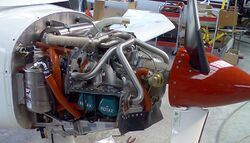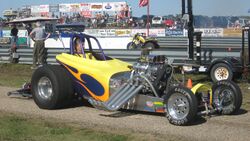Engineering:Tuned exhaust

A tuned exhaust system is an exhaust system for an internal combustion engine which improves its efficiency by using precise geometry to reflect the pressure waves from the exhaust valve or port back to the valve or port at a particular time in the cycle.
Two-stroke engines
In many two-stroke engines, the exhaust port is opened and closed directly by the position of the piston rather than by a separate valve, which restricts the timing of its operation; Typically, the port remains open long after is optimum, allowing some of the incoming charge to escape. This can be partly addressed by use of a tuned exhaust system to deliver a pulse of positive pressure prior to the port closing, to retain the charge.
Alternatives
Direct-injection two-stroke diesel engines tend to use exhaust valves actuated either by camshafts or electronic control, rather than exhaust ports. This system is called uniflow scavenging. Opposed piston engines are inherently uniflow-scavenged, but these do use piston-controlled cylinder ports. Two-stroke opposed piston engines such as the Napier Deltic and Junkers Jumo 204 engines use one piston to control the inlet port and the other the exhaust, allowing more flexibility in timing. A variation of this approach is taken by the split-single engine, in which two cylinders share one combustion chamber, with the piston in one cylinder controlling the transfer port and the other the exhaust port.
Four-stroke engines
Extractor manifolds
Most non-turbo performance cars and high-performance four-stroke motorcycles use extractor manifolds (headers in American English), as do most non-turbo racing cars. Extractor manifolds are also available as aftermarket accessories to suit many engines.
Extractor manifolds offer the following advantages over the simple manifolds often fitted to non-performance engines:
- Separating the gas flows from the individual cylinders so that undesirable inter-cylinder interference is avoided.
- Maintaining an optimum gas velocity by carefully chosen tube diameter.
- Allowing the individual cylinders to assist one another by means of the negative pressure waves generated at the collector, where the individual exhausts merge.[1]
This type of exhaust system can be used with or without a muffler, and so can be used on both race and road vehicles.
See also
Two-stroke systems
Four-stroke systems
- Exhaust system
- Exhaust manifold
- Scavenging (automotive)
- Aftermarket exhaust parts
- Pressure wave supercharger
References
- ↑ The Design and Tuning of Competition Engines, Philip H. Smith, pp137-138







